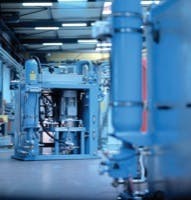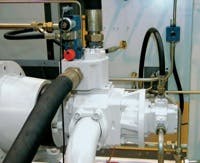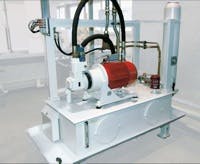When you're enjoying the latest interactive amusement park attraction with your kids, you expect to hear the the talking mouse — or dog or robot. You don't expect to hear the hydraulic system behind the wall, even if it is making all the motion possible. This may be a somewhat obvious example of the need for quiet hydraulics. But sound levels are also becoming an issue in more industrial applications — not just in the more typical areas, such as rides and simulators.
Companies are growing increasingly concerned about subjecting their workers to plant noise. For example, automotive plants have seen an increase in health costs related to noise issues, and are looking to make their plants more ergonomic for the workers, so that ear protection isn't necessary. Many plant and machine specifications are requiring maximum noise of 85dBA. What's more, many require this with no enclosures, which often aren't reinstalled after servicing, defeating their purpose.
In the EU, a noise protection directive (2003/10/EU) has been in force since early 2006. It not only reduces the maximum permissible effect of noise on human beings, but it also lowers the permitted maximum level to a uniform 80 dBA, calculated on the basis of the average levels during an 8-hr/day shift.
Causes and cures
Noise in hydraulic systems can be created by many components. Pressure drop and turbulent flow create the energy, which is then transmitted — and often amplified — by other components or structural members. Many times, conflicting constraints amplify the situation. For example, cost constraints may drive smaller line sizes or structural members, which then have less mass to absorb the energy — and have a lower resonant frequency. Some other issues to consider:
● Minimizing pressure drops and line speeds are good hydraulic design guidelines anyway, but they must be emphasized when noise is an issue.
● Tank design and supporting structure must be considered carefully to minimize vibration transmission.
● Components known to have inherent noise or vibration are best isolated (or de-coupled) from supporting structure or rigidly mounted items.
● High efficiency and balanced electric motors, pulsation dampers, creative design of the tank and supporting structure, and axial-piston pumps are all features that can be incorporated.
● Pulsation dampers can help reduce pulsations inherent in the system. If the machine duty cycle is regular and specific, an accumulator drive circuit may be appropriate, which can greatly reduce the size of the pump and motor required. Because the motor and pump are usually the source of most of the HPU noise, a smaller motor-pump would operate more quietly. Of course, sizing the plumbing must be done carefully to minimize pressure drop and line noise.
Most noise-reduction practices involve inherent costs, so before specifying a maximum noise level, you may want to consider what is really necessary before being shocked at the cost of what was specified.
Accumulator charging circuits
Hydraulic power units with accumulator charging circuits, Figures 2 and 3, incorporate both energy efficiency and low noise emissions. The basic components are a fixed displacement pump, a hydraulic accumulator, and a hydraulic valve circuit.
This arrangement enables the pump to switch from free circulation into accumulator charging function if a specified minimum load pressure in the accumulator fails to be attained. At the end of the closing and charging period, the upper accumulator load pressure is attained, and the fixed-displacement pump switches back into free circulation; this may also be designed as a filter circuit or as a filter cooling circuit if required.
The energy-saving benefits of the circuit lie in the fact that, in delivery mode, the pump consistently operates at high efficiency. Hydraulic energy dissipation is low in circulating operation (which is practically pressure-free).
The accumulator charging principle also may achieve a distinct reduction in noise, even in a non-encapsulated unit construction. This means that low-noise fixeddisplacement pumps of internal gear construction can also be used at reduced speed, with the noise occurring only at intervals. If the selected accumulator charging circuit is operated at full limit, only unobtrusive switch-on and switch-off noise will occur.
Dave Wenner is manager of power unit and industrial manifold products for Bosch Rexroth Corp., Bethlehem, Pa. For more information, call (800) 739-7684 or visit www.boschrexroth-us.com.




